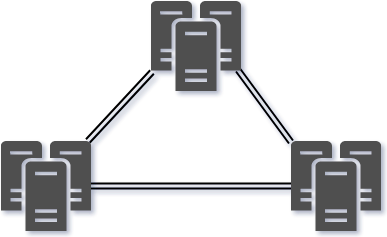| Component | Description |
|---|---|
| vPC Domain | Includes the vPC Peers, KeepAlive Links and the PortChannels that use the vPC technology. |
| vPC Peer Switch | The other switch within the vPC domain. Each switch is connected via the vPC peer link. Its also worth noting that one device is selected as primary and the other secondary. |
| vPC Member Port | Ports included within the vPCs. |
| vPC Peer Keepalive Link | Connects both vPC peer switches and carries monitoring traffic to/from each peer switch. Monitoring is performed to ensures the switch(s) is both operational and running vPC. |
| vPC Peer Link | Connects both vPC peer switches. And carries BPDUs, HSRPs, and MAC addresses to its vPC peer. In the event of vPC member port failure it also carries unicast traffic to the peer switch. |
| Orphan Port | An orphan port is a port that is configured with a vPC VLAN (i.e a VLAN that is carried over the vPC peer link) and is not configured as a vPC member port. |
A virtual PortChannel (vPC) allows links that are physically connected to two different Cisco Nexus™ 5000 Series devices to appear as a single PortChannel to a third device. The third device can be a Cisco Nexus 2000 Series Fabric Extender or a switch, server, or any other networking device. A vPC can provide Layer 2 multipathing, which allows you to create redundancy by increasing bandwidth, enabling multiple parallel paths between nodes and load-balancing traffic where alternative paths exist.
After you enable the vPC function, you create a peer keepalive link, which sends heartbeat messages between the two vPC peer devices.
The vPC domain includes both vPC peer devices, the vPC peer keepalive link, the vPC peer link, and all the PortChannels in the vPC domain connected to the downstream device. You can have only one vPC domain ID on each device.








